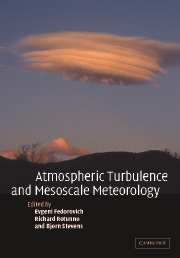Book contents
- Frontmatter
- Contents
- Preface
- Douglas K. Lilly: a biography
- Part I Atmospheric turbulence
- Part II Mesoscale meteorology
- 6 Model numerics for convective-storm simulation
- 7 Numerical prediction of thunderstorms: fourteen years later
- 8 Tropical cyclone energetics and structure
- 9 Mountain meteorology and regional climates
- 10 Dynamic processes contributing to the mesoscale spectrum of atmospheric motions
- Appendix A Douglas K. Lilly: positions, awards, and students
- Appendix B List of publications by Douglas K. Lilly
- Index
- Plate section
7 - Numerical prediction of thunderstorms: fourteen years later
Published online by Cambridge University Press: 04 August 2010
- Frontmatter
- Contents
- Preface
- Douglas K. Lilly: a biography
- Part I Atmospheric turbulence
- Part II Mesoscale meteorology
- 6 Model numerics for convective-storm simulation
- 7 Numerical prediction of thunderstorms: fourteen years later
- 8 Tropical cyclone energetics and structure
- 9 Mountain meteorology and regional climates
- 10 Dynamic processes contributing to the mesoscale spectrum of atmospheric motions
- Appendix A Douglas K. Lilly: positions, awards, and students
- Appendix B List of publications by Douglas K. Lilly
- Index
- Plate section
Summary
Introduction
Numerical weather prediction (NWP) has been an essential part of large-scale weather forecasting since the1950s. Although the steady increase of computer power has pushed operational numerical models to higher resolution and greater levels of sophistication, until the 1990s, the numerical simulation of convective clouds and storms was conducted only for basic research, without much thought towards forecast application. In 1990, Douglas Lilly wrote an article entitled “Numerical prediction of thunderstorms eacute; has its time come?”, stating that it was time for convective-storm scientists to apply their knowledge to the purpose of weather prediction. Lilly (1990) argued that continued support and vigor of convectivestorm modeling research depends on identifying an applied objective, and weather prediction is the principal reason for the support that we are given by our fellow citizens.
Since the first three-dimensional cloud simulations were attempted in the 1970s (see, e.g., Miller and Pearce, 1974; Schlesinger, 1975; Klemp and Wilhelmson, 1978), active research has been conducted in this area and almost all of the studies have focused on the understanding of the dynamics of convective clouds. Due to the lack of detailed data on convective clouds and storms for initialization and comparison, and computational constraints, numerical simulations of convection using cloud models have been started from composite soundings and artificial thermal bubbles. Although some of the simulations were compared with reflectivity observations (Klemp et al., 1981; Wilhelmson and Klemp, 1981), the comparison was made only in a qualitative sense. Lilly (1990) argued that, with the availability of the nationwide radar WSR-88D (Weather Surveillance Radar eacute; 1988 Doppler) observational network and the rapid increase in computer power, it was time to launch a new research endeavor, which would examine whether storm-scale NWP was a realistic goal.
- Type
- Chapter
- Information
- Atmospheric Turbulence and Mesoscale MeteorologyScientific Research Inspired by Doug Lilly, pp. 139 - 164Publisher: Cambridge University PressPrint publication year: 2004
- 3
- Cited by



